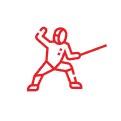The Psychology of Reading Your Opponent in Fencing
In fencing, technical skills such as footwork, timing and blade control are only half the battle. The other half is mental: understanding your opponent. Anticipating movements and intentions can be the difference between victory and defeat. In open‑skill sports like fencing, competitors use anticipatory processes based on experience and mental imagery to identify tactical goals. During the preparatory period before an action, fencers focus attention and plan their responses. Anticipating an opponent’s intentions gives more time to prepare and execute a response. This article explores how to read opponents effectively, train your perception and apply strategic adaptations during a bout.
Why Reading Opponents Matters
Executing perfect technique at the wrong time or against the wrong setup is ineffective. Reading an opponent allows you to predict actions, identify patterns and adapt strategy mid‑bout. The ability to predict what an opponent can or cannot do depends on reading them; seeing what the opponent does or doesn’t do helps you plan for likely actions. Observing an opponent closely lets you avoid skewering yourself on the opponent’s point and adjust your tactics accordingly.
Key Observation Skills
Analysing Footwork
Footwork reveals much about an opponent’s intentions. We advise starting observations from the ground up: look at the position of the feet, whether the front foot points towards you, whether the back foot aligns with the front, and whether the opponent stands flat‑footed or on the balls of their feet. These details indicate movement style and speed. Deeply bent knees suggest readiness for quick movement, while weight distribution hints at whether the opponent will move forward or backward.
Experienced fencers also watch for patterns in an opponent’s footwork and timing. Fencing is as mental as it is physical. As you gain comfort on the strip, you start seeing subtle cues that signal intentions. Slower retreats might indicate vulnerability to sudden acceleration, while bouncy advances could mask aggressive lunges.
Studying Blade Habits
The way an opponent holds and moves their weapon provides clues. Observing how the opponent holds the weapon and where the arms are placed in the on‑guard position indicates whether they will engage the blade aggressively or defensively. A high, extended guard may precede offensive actions such as beats or flèche attacks, while a withdrawn arm could signal a defensive parry or counter. Notice repetitive patterns: does your opponent initiate attacks from a specific guard or rely on certain parries? Recognising these habits allows you to anticipate their next action and prepare a counter.
Identifying Feint Responses
Feints (false attacks) are useful not only for drawing reactions but also for gathering information. Throw a harmless feint and note how your opponent responds: do they panic and retreat, stay composed and parry, or attempt a counterattack? Their reactions reveal defensive tendencies and timing. While not all sources discuss feints explicitly, the idea aligns with general advice about awareness. Outwitting an opponent involves staying calm while being aware of the opponent’s strategies and movements. By provoking reactions and observing them, you can adapt your strategy accordingly.
Psychological Cues
Reading an opponent isn’t just about technique—it’s also about body language and mental state. Here are some cues to watch for:
-
Body tension: A sudden stiffening of muscles can signal an impending attack. A slouching or hunched opponent may be tired or scared. Conversely, an upright, tense posture can indicate readiness to lunge.
-
Eye focus: Opponents often glance toward their intended target area before attacking. Watch where their eyes go: do they look at your hand before going for a disarm or at your front shoulder before lunging?
-
Breathing patterns: Rapid breathing may indicate fatigue and slower reaction times, while controlled breathing suggests readiness. Staying calm yourself is crucial; Mental gamesmanship involves staying calm, focused and one step ahead.
Training to Read Opponents
Video Review
Studying recorded bouts helps you identify patterns in an opponent’s footwork, blade habits and tactical choices. Developing a strategic mindset is key to success; it allows fencers to think ahead, anticipate opponents’ moves and plan the best course of action. Reviewing videos of your own bouts and those of others trains this anticipatory mindset. Watch first in real time to understand the general strategy, then slow down to analyse specific actions and timing.
Simulation Drills
Drills that mimic real bout situations help sharpen observational skills. For example, practice reacting to varied, unpredictable attacks by a partner or coach. Mix offensive and defensive drills that require you to watch for footwork cues and blade angles. Fencers’ ability to stay calm and focused while being aware of their opponent’s strategies is a mental skill that can be strengthened through such simulations.
Mental Rehearsal and Preparation
Visualization and positive self‑talk enhance mental preparedness. During visualization exercises, picture an opponent’s telltale cues: how their feet, hands and body might telegraph an attack; and rehearse your response. Proper training not only develops reflexes but also helps build confidence and the ability to read an opponent’s movements and anticipate their next move.
Reading your opponent is a mental skill that transforms technical ability into tactical dominance. By observing footwork, studying blade habits, and recognising psychological cues, you gain insight into your opponent’s intentions. Anticipation and focused attention during the preparatory period give fencers extra time to prepare responses. Field observations emphasise the importance of sight and touch for understanding foot placement, body posture and arm positioning. Developing this skill requires deliberate practice: studying videos, performing simulation drills and engaging in mental rehearsal. As you refine your ability to read opponents, you move from merely reacting to controlling the bout’s tempo. Keep training, stay curious and explore more insights and training tips from the Azza Fencing community.





